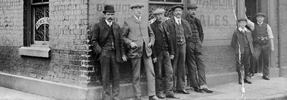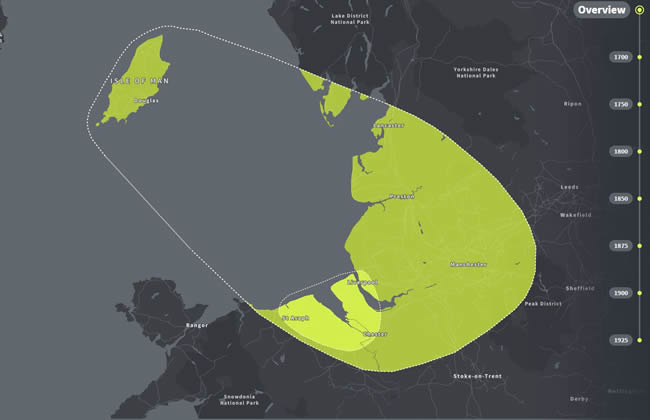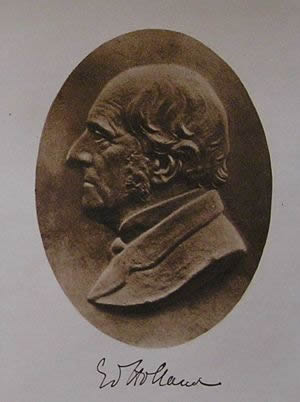Holland DNA by Brian Holland
DNA research was introduced into the sphere of genealogy as a means of assisting in the resolution of problems within family tree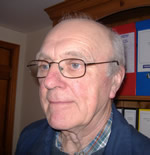 s constructed from conventional means. Several web sites set themselves up in the late 20th century aiming to provide a facility for comparing primarily Y- chromosome DNA results, these included ancestry.co.uk, family tree dna, my heritage and others. Initially, ancestry provided Y-chromosome DNA results which indicated the Haplogroup deduced from the participant’s results, the origin of the Haplogroup, and identification of the approximate number of generations to the nearest close relative identified within the database. Initially, 12 STR marker points were used, but this was steadily increased to improve accuracy of the prediction techniques, this had an adverse effect on the cost of the test. The website “y-search.org” was set to enable willing participants from any of the DNA providers to enter their data into the data-base and compare their results with others. Regrettably, the y-search website was closed down in 2018 in response to an EU directive involving improved data protection.
s constructed from conventional means. Several web sites set themselves up in the late 20th century aiming to provide a facility for comparing primarily Y- chromosome DNA results, these included ancestry.co.uk, family tree dna, my heritage and others. Initially, ancestry provided Y-chromosome DNA results which indicated the Haplogroup deduced from the participant’s results, the origin of the Haplogroup, and identification of the approximate number of generations to the nearest close relative identified within the database. Initially, 12 STR marker points were used, but this was steadily increased to improve accuracy of the prediction techniques, this had an adverse effect on the cost of the test. The website “y-search.org” was set to enable willing participants from any of the DNA providers to enter their data into the data-base and compare their results with others. Regrettably, the y-search website was closed down in 2018 in response to an EU directive involving improved data protection.
In order to reduce the cost of acquiring the DNA data, Ancestry and other providers changed their methodology from providing Y-chromosome DNA results to autosomnol DNA. The result is that they no longer provide Y-chromosome data, or indication of Haplogroup type; instead they provide details of the nearest possible cousins. This is a retrograde step for the serious genealogist as it is no longer affordable to compare the DNA of paternal line descendants as only a few companies now provide Y-chromosome and Haplogroup data and it is prohibitively expensive. To identify a potential relative within the genealogical timeframe he has to be in the same Haplogroup, not having this data limits the scope of the research. The autosomnal DNA method is useful in identifying possible close relatives within an eight-generation timescale, and may throw up connections that would not appear with the Y-chromosone method. Some companies now offer both methods but this adds to the cost.
At the time of writing the recommendation is that the Y-chromosome results should provide data at a minimum of 43 STR marker points but preferably at 111 marker points.
Prior to Ancestry changing from the Y-chromosome method to the autosomnal method, Paul Holland, my first cousin once removed, and our seventh cousin Timothy Holland via our common ancestor Owen Holland of Newmarket, both obtained results from the 43 STR marker Y-chromosone test. Perhaps not surprisingly their results agreed on 41 of the 43 markers, the differences being by one allele point respectively at markers 389ii and 449. The Ancestry deliverables also confirmed that they had a common ancestor within the 8-generation timescale. This result confirmed our confidence in the 8-generation pedigree descending from Owen Holland and Catherine Davies, which had been derived with the aid of Parish records, wills, marriage licences, birth and death certificates etc. Regrettably, ancestry deleted the Y-chromosome data-base when they changed over to autosomnal testing. Paul Holland also undertook the autosomnal DNA test, but to date it has not thrown up any common ancestors. The Ancestry data-base appears only to be of use in identifying possible relations if the participant has submitted a reliable pedigree going back 8-generations.
The following information has been derived from the deliverables of the two testing methods at ancestry.
The Y-chromosome data identified us as being in Hapologroup I1 (Stonemasons) (Now known as I-M253). This group primarily occupied Norway, Sweden and Denmark and parts of Finland. There are two possible ways this Haplogroup could have arrived in Britain, either directly via the Viking invasion, or indirectly via the Norman invasion. At the time of writing the University of Leicester is conducting a DNA investigation, “The Viking DNA Project”, which indicates that some of today’s Normans probably are Viking descendants. Normandy is the only sustainable colony established by the Vikings in mainland Europe outside of Scandinavia. Over 45% of the Scandinavian population belongs to Hapologrop I1 in some areas, but a Germanic origin is also possible. In haplogroup I1, some Norman Y-chromosomes show an affinity with the Germanic, while others show an affinity with the Scandinavians. However, it is tempting to consider l1 as a mark left by the Vikings in Normandy because it is present in approximately the same proportions as those observed in other populations with known Viking history. If the Viking Project confirms that some of the Normans that invaded England in support of William the Conqueror were from Haplogroup I1, it is tempting to consider that the origins of the Holland line descending from Adam de Holland were of Norman descent. This could explain why the French coat-of-arms “azure a semi of fleur-de-lis” was selected as the field of the Holland shield. Holland derives from the name Hoiland whose origins are Scandinavian.
From the data within the ancestry autosomnal data-base, as illustrated below, it has been deduced that many of our ancestors resided in Lancashire, the Wirral and N Wales. This is consistent with the conclusions of our research and reflected in the overall pedigree.
Lancashire & Cheshire
Adam de Holland, alive in the late 11th century, is reputed to have been of Litherland, an area east of Liverpool, and his grandson Adam de Holland was of Eakaston (Euxton) which is in close proximity. Their supposed descendant Matthew de Holland, circa 1175, was of UpHolland, Lancs., which is further East near Wigan. The descendants of Matthew de Holland were predominately residing in the highlighted area with property as follows: -
Sutton - Within the borough of St Helens, North of Liverpool, came into the possession of Richard de Holland, son of Robert ap Matthew de Holland in the mid-13th century and remained in the family until the 18th century.
Sharples - The manor lies to the North West of Bolton and was granted to Sir William de Holland, s/o Sir Thurston ap Robert ap Matthew de Holland by Sir Roger de Sharples in 1315. The Manor was then granted in 1316 to Thurston de Holland after which it became part of the Denton estate.
Denton -Lies five miles East of Manchester. It came into the possession of Thurston de Holland via his mother Margaret de Shoresworth in the mid-14th century and remained in the family until the 17th century.
Clifton - The manor of Clifton lies between Manchester and Bolton and passed into the hands of William de Holland, s/o Thurston de Holland s/o Sir William de Holland and Margaret Shoresworth in the mid-14th century. It remained in the family until the late 17th century.
Mobberley - Situated close to Knutsford in Cheshire the property was bought by William Holland, a descendant of Sir Thurstan de Holland of Denton in 1650, it remained in the family until it was sold in the late 19th century.
Sandlebridge and Knutsford - Situated close to Knutsford. Colthurst House was acquired through the marriage of Mary d/o Peter Colthurst of Sandlebridge in 1717 to John Holland of Mobberley, great-grandson of William Holland of Mobberley. The property was inherited by John’s 2nd son Samuel Holland who married Anne d/o Peter Swinton of Knutsford from whom descended the Viscounts Knutsford and the Holland Hibberts and others.
Further details of the descendants of the above Lancashire and Cheshire families can be found in Bernard Holland’s "The Lancashire Hollands".
North Wales
In addition to the Lancashire and Cheshire families the Hollands in N Wales are also believed to be descended from Adam de Holland of Euxton. In particular the prominent families of Eglwys Bach, Kinmel and Abergele, Plas Berw Anglesey, Llangelynnin and Newmarket are all believed to have descended from Roger Hoesgin Holland who arrived in N Wales in the mid to late 14th century. Also, the Hollands of Conwy are believed to be descended from the same Adam de Holland. Many of the descendants of Owen Holland of Newmarket, who we believe to be a descendant of Roger Hoesgyn Holland, migrated to the Wirral and Liverpool area in the mid to late 19th century.
Staffordshire
There was also a family of Hollands settled in Barton-Under-Needwood, Staffordshire, they claim their descent from Richard de Holland who was in possession of the manor of Barton from the early 14th century. This Richard de Holland was a kinsman of Robert de Holland ap Robert de Holland ap Thurston ap Robert ap Matthew de Holland as described in “Some Records of the Holland Family” based on the notes of William Richard Holland of Barton-Under-Needwood. It is not clear who the ancestor of Richard de Holland was, but it seems most likely that he came from the Sutton branch whose progenitor was Richard ap Robert ap Matthew de Holland, in which case he was possibly a first cousin of Robert de Holland. This possibility is explored further below.
Although some of the lines of the Lancashire and Welsh Hollands are theoretically extinct, it cannot be discounted that there are unknown descendants that have so far not been traceable by conventional means. The Ancestry prediction of where those descendants are most likely to exist, highlighted as the green area on the above chart, is compatible with our expectation as portrayed in the pedigree produced from conventional research, supplemented by deduction and intuition in areas where provenance is scarce. The search for additional documentation has been exhaustive and the probability of finding additional material is low. The only means available to increase the probability of the accuracy of assumptions in areas of uncertainty is by Y-chromosome DNA comparison.
Viking DNA
A genetic survey was carried out between 2002 and 2007 to investigate the evidence of the existence of Vikings in the Wirral and North Lancashire areas. (Ref Viking DNA-The Wirral and West Lancashire Project-ISBN 13-978-1-4665-9085-4). The aim was to discover the depth of these Viking roots by tracing the DNA of the local populace back to their Viking ancestors. The evidence based on historical and place-names suggests a past presence of Viking incomers, and demonstrated that samples ascertained using surnames present in medieval times show a markedly greater proportion of Scandinavian ancestry.
The belief is, that based on archaeological, place-name and historical evidence, that the northwest of England was once heavily settled by Norse Vikings. Samples from Old Wirral and Old West Lancashire revealed up to 50% Norse admixture in the Y-chromosome from old families in these areas. These findings are compatible with those derived from the autosomnal DNA results derived from the ancestry DNA database as described above. The surname Holland was included in the sample groups for West Lancashire.
The I1 Haplogroup has a top match of 21% on a frequency basis to Jokkmokk in Sweden with Haplotype markers as follows: - DYS 19=14, DYS 390=23, DYS 391=10, DYS 392=11, DYS 393=13, DYS 3891=12 and DYS38911=28. These are identical to our own DNA profile. The I1 Haplogroup represents the hunter gatherer populations present in northern Europe before the introduction of farming methods 10,000 years ago, and is found in the highest frequencies in Scandinavia; I1a is a smaller sub-group of I1 and is found in smaller frequencies in Britain and central Europe. Approximately 22% of the population in North west England are in haplogroup I and about 15% in northern France.
Further investigation is required to establish whether any of the I1 population could have come from Northern France during the invasions of the Normans in the 11th century. Any similarity in DNA profile between ourselves and possible Normans with Viking ancestry emerging from the Leicester University “Viking Project” may strengthen the possibility that Adam de Holland originated in Normandy, hence the choice of the azure field with semi de fleur de-lis as the basis of the Holland coat-of-arms.
DNA and Physical Features
The question arises as to whether Y-chromosome DNA is accompanied by similarity of physical features. Haplotype STR analyses is used as a means of forensically identifying individuals, usually as a means of solving crimes where perpetrator DNA is available. It seems therefore that individuals with matching haplotype STR’s will share similar physical features. “DNA phenotyping” – reconstructing physical features from genetic data- is the subject of research studies and is rapidly developing so it is not inconceivable that males of the same haplogroup with similar haplotype STR’s will exhibit similar physical characteristic.
William Richard Holland of Barton-Under-Needwood and Ashbourne (1836-1916) enthusiastically researched his family history dating back to Richard de Holland who settled in Barton in 1313. Unfortunately, he died before he was able to put any formality to his research; however, his papers were edited and issued in the form of a book “Some Records of the Holland Family” which was published in 1920 by Phillip Allan & C0 Ltd, London in small quantities for family interest only. William had a Solicitor’s practice in Ashbourne, Derbys. Soon after William became established Captain Frederick Holland R.N., a descendant of the Hollands of Mobberley and Knutsford, descendants of the Hollands of Upholland, purchased Ashbourne Hall.
Both these gentlemen were actively involved in the affairs of Ashbourne and undoubtedly shared an interest in family history. Frederick Holland died in 1860 and William composed a poem especially for his funeral. Amongst William’s papers was a letter dated 1902 to Walter Holland of Liverpool thanking him for a copy of “The Hollands of Mobberley and Knutsford” that he had kindly provided. (reproduced in the said book pages 53 and 54). Walter Holland was a nephew of Frederick Holland. Within the letter there are two references to physical features of the Holland family which I have repeated here as follows: -
“The typical stature of the men of our family is 5 ft 10 ins to 6 ft 4 ins. I am just 6 ft and half ins sixty-seven years old, and active for my age. I have a son Richard who has shot up to 6 ft 4 ins. We have a typical Holland head, which I noticed in several of the portraits in the beautiful History of the Branch of your Race. ---”
“I knew Captain Herbert Holland mentioned on page 82 of your book. He had the Holland head--------My family have always claimed the arms of Holland ancient, as given in the Calais Roll and the books on heraldry, but for centuries my ancestors have been quiet country gentlemen, not wealthy, and unostentatious.”
Unfortunately, William fails to describe what features comprise the typical Holland head, however, by examining a selection of photographs and portraits of Holland families it is possible to deduce what he was getting at. These images are produced below at a comparative scale and show some interesting similarities. For comparison I have also added some none- related images of prominent people who have been established to be in the I1 Haplogroup for comparison.
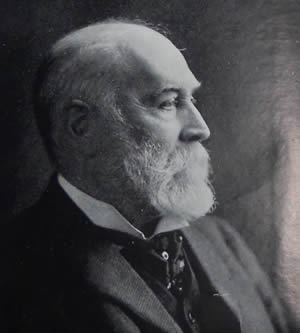 |
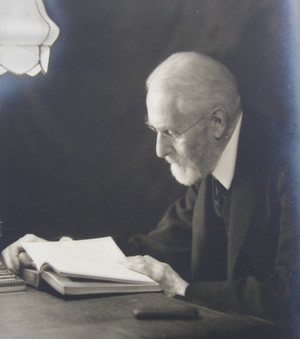 |
|
| William R Holland of Barton Under Needwood | Francis Caldwell Holland |
Frances Caldwell Holland was great-grandson of Sir Henry Holland of Knutsford, and first cousin of the above-mentioned Walter Holland. There are obvious similarities in the features of these two gentlemen, yet their nearest common ancestor is believed to be Thurston de Holland ap Robert ap Matthew de Holland of Upholland, i.e., twenty generations above. The Herbert Holland referred to by William R Holland was the son of Edward Holland MP, a profile of him appears in the Hollands of Mobberley book and is similar to that of his father shown below.
A typical Holland head has the cranium front bone sloping backwards from the eyebrows and in line with the nose, as shown in the sketch below. The geometrical features are broadly in line with those outlined in the same sketch, the nose is quite prominent and generally generous in width. A receding hairline is quite common as shown in the below images, but there are some exceptions.
John Holland 2nd Duke of Exeter was buried in a tomb in St Catherine’s Chapel, London in 1447. This chapel, the tomb, and its contents were removed to Regents Park during the demolition of the area to facilitate the construction of St Katherine’s docks which commenced in 1825.
During this process the skeletal remains of John Holland were exposed and described by a contemporary journalist as follows “The cranium is small and retiring, which those who profess to be learned in such matters say is evidence of royalty and legitimacy, as well as valour. The teeth are remarkably perfect”.
Bernard Holland in his book “The Hollands of Lancashire, p 201”, points out that the effigy of John Holland portrayed on the tomb does not show a retiring cranium at all, but a straight forehead”, and hypothesises that it may have belonged to one of his entombed wives. However, the description of the cranium is compatible with those that are typical of the so-called Holland head, and are therefore more likely to have belonged of John Holland. I have come across no evidence to suggest that the effigies adorning entombed remains were an exact likeness to those of the occupant."
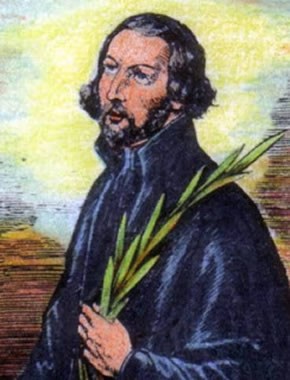 |
The image left is believed to be that of Thomas Holland, a Jesuit priest who was executed in 1642 (See Bernard Holland, page 2252-258.) | ||
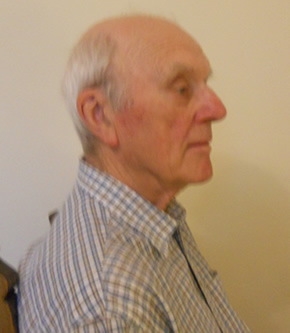 |
 |
|
| Charles Brian Holland in 2020 | William R Holland of Barton Under Needwood |
The image on the left above is that of myself, Charles Brian Holland; as shown in the main pedigree at the start of this book. It is highly likely that I and the other Welsh descendants have a common ancestor Roger Hoesgyn Holland, who is believed to be descended from Sir Adam de Holland the possible father of Matthew de Holland of Upholland. There are therefore at least 20 generations between William and Sir Adam and 23 generations between myself and Sir Adam. As can be seen these head profiles are very similar, and may represent what William Richard Holland was alluding to as the Holland Head, which is replicated in the image of Frances Caldwell Holland above.
Physical features are clearly related in some way to one’s DNA profile, however the subject is complex as one’s DNA is shared 50 % from each of one’s parents and 25 % from each of one’s grandparents and so on. Identical twins and fraternal twins will have identical Y-STR profiles, but not necessarily 100 % identical complete DNA profiles. Each generation receives genes from the paternal line which will have some influence on physical features, the extent of which depends on some degree to the strength of the particular maternal DNA. One might imagine that if one’s maternal grandfather was from the same haplogroup as one’s father, there may be a higher probability of inheriting his genetic features than in the case of a maternal grandfather being from a totally different haplogroup.
At the time of writing this is the subject of research, those genes influencing hair and eye colour having already being identified. The research is complex and involves reverse engineering from physical facial data to known DNA profiles. It is perceived in the future that it may be possible to reconstruct a facial image from a known DNA profile.
Photographic portraits date back to the middle of the 19th century, hence, theoretically, photographic evidence of adult family resemblance can extend up to approximately 180 years at the time of writing, i.e., seven generations. Beyond that we are dependent upon family portraits if they exist, this is only likely if one is fortunate to descend from an armigerous family line, however, one is dependent on the skill of the artist to produce an accurate likeness.
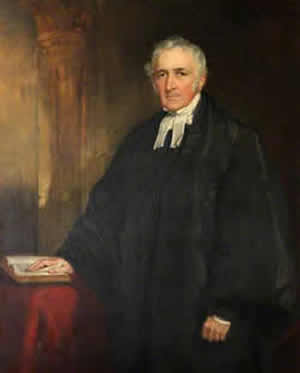 |
The earliest portrait I have found in the Welsh Holland line is that of William ap William ap John Holland of Teyrdan, Kinmel (b1791, d1863). Below is a comparison of the facial features of William Holland and Sir Henry Thurstan Holland, 1st Viscount Knutsford, who were living in the 19th century. Their general appearance and facial geometry are remarkably similar considering that their common ancestor lived 20 generations earlier. Photo © Erddig National Trust |
 |
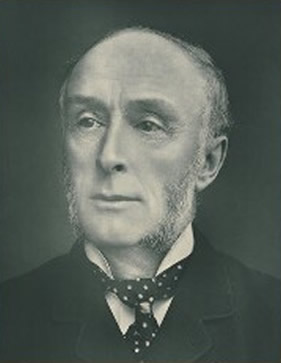 |
|
| Rev William Holland | Sir Henry Thurstan Holland |
The following images are those of myself taken in 2020. The leading geometrical features are included in the accompanying sketch, and compared with those of the above two images, as best as can be achieved bearing in mind that heads are inclined.
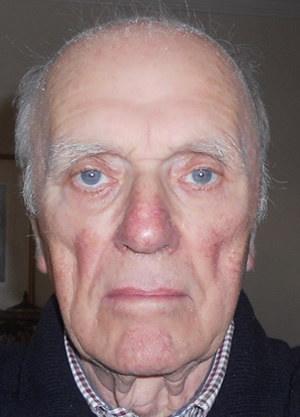 |
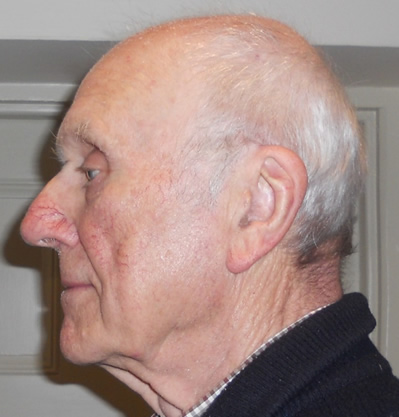 |
|
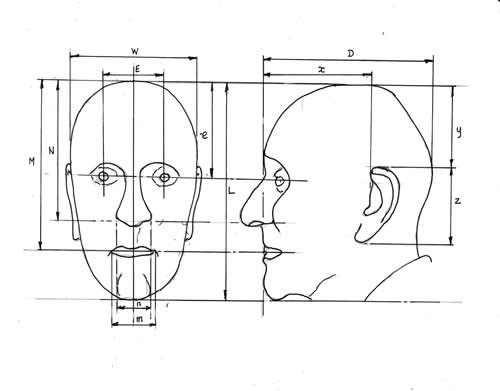 |
||||||||||
L= Vertical Length from chin to apex (Teeth clenched)). |
||||||||||
| W | E | e | N | M | m | n | D | x | y | z |
| 0.66L | 0.47W | 0.44L | 0.63L | 0.78L | 0.36L | 0.27L | 0.87L | 0.65D | 0.37L | 0.35L |
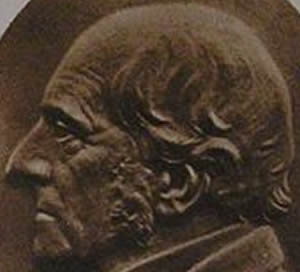 |
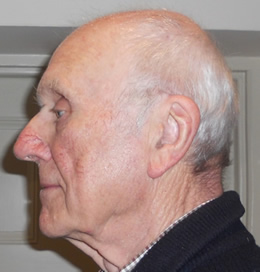 |
|
| Edward Holland | CB Holland |
This similarity may be what William Richard Holland was alluding to when he referred to the Holland head in his letter to Walter Holland. In addition to the similarity in profile there are geometric similarities in facial geometry, in particular in relation to the location of the eyes, nose and mouth relative to one another, and with respect to their vertical position within the length L as shown in the above diagram. This has been ascertained by comparing the images at the same scale within a Microsoft word document and with the use of tracing paper to facilitate the comparison.
In addition to the images shown above, images of other members of the Holland family of Mobberley and Knutsford are shown below. The relationships between these individuals and those of other Holland branches where images exist are shown in the pedigree below: -
Lancashire Descendants - Mobberley and Knutsford
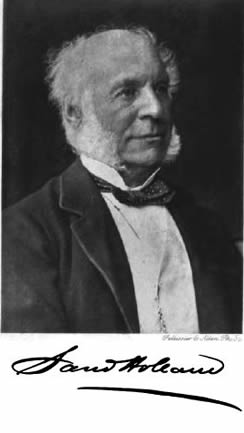 |
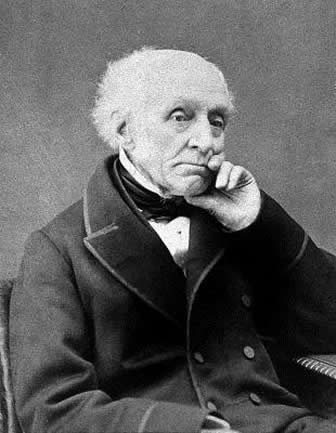 |
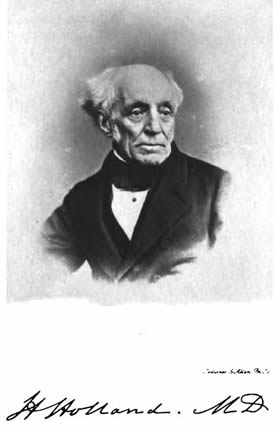 |
||
| Samuel Holland | Samuel Holland (b1734) | Sir Henry Holland (b 1788) 1st Viscount Knutsford | ||
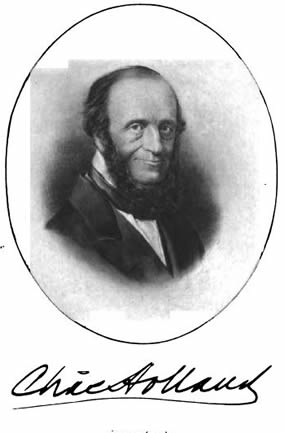 |
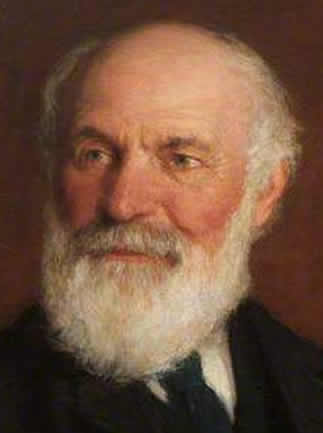 |
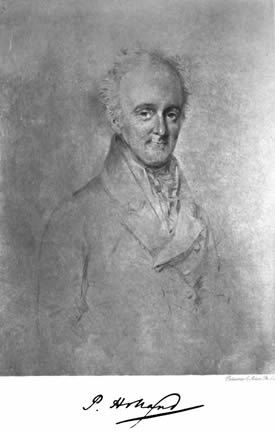 |
||
| Charles Holland | Samuel Holland (born 1803) | Dr Peter Holland | ||
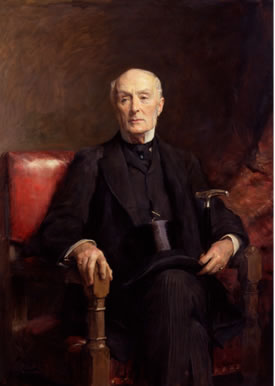 |
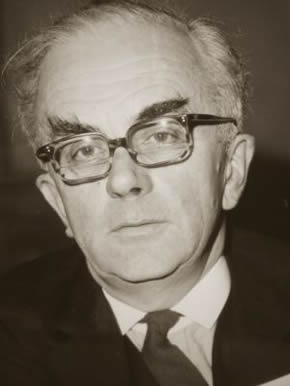 |
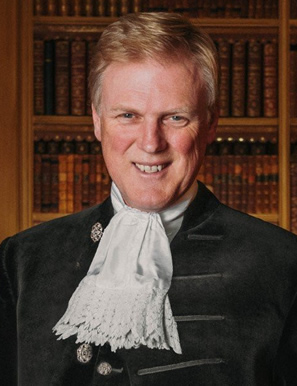 |
||
| Henry Thurstan Holland | Julian Thurstan Holland | Henry Thurstan Holland | ||
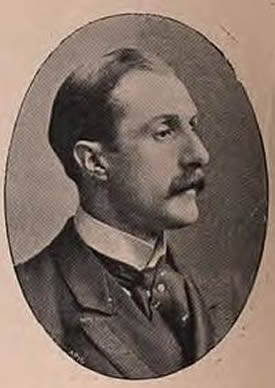 |
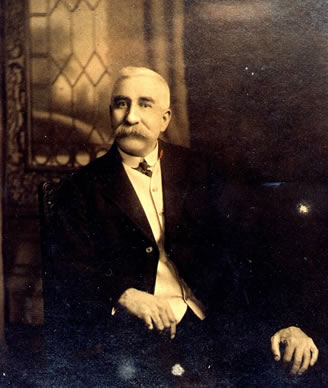 |
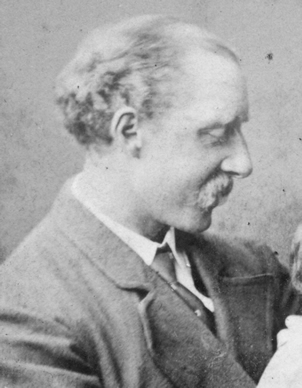 |
||
| Lionel Raleigh Holland | Thomas Bagnall Holland (born 1856) | Richard Holland (born 1858) | ||
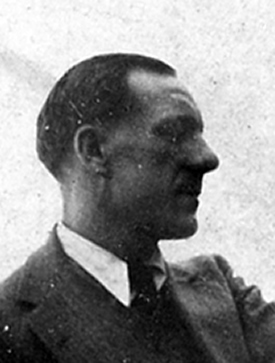 |
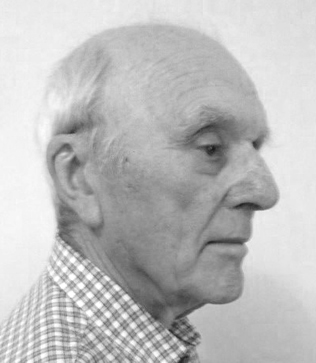 |
|||
| Robert son of Thomas Bagnall Holland | Brian son of Robert Holland (left) | |||
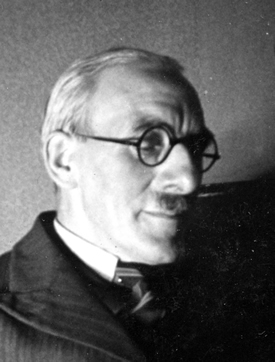 |
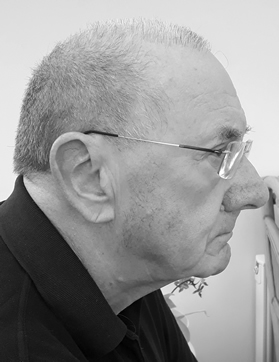 |
|||
| Richard son of Thomas Bagnall Holland | Paul grandson of Richard Holland (left) | |||
 |
| This pedigree relates to the images above. |
The question arises as to how much the similarities in skull profile and facial geometry are peculiar to the Holland line, and how much are inherited from the Haplogroup I1. In an attempt to answer this question, courtesy of the eupedia.com website, I compared the images of famous people known to be from the I1 haplogroup with the images of Holland descendants above. There appear to be many similarities between these two groups which I believe confirms at least that the separate Holland lines originate from the I1 haplogroup, which according to eupedia.com mutated from the rest of haplogroup I some 27,000 years ago along with haplogroup I2. I1 later mutated to I1a about 15,900 years ago (Phylogeography of Y-chromosome haplogroup I1 reveals distinct remains of prehistoric gene flow in Europe, NCBI publication).
According to Y-STR analyses (www.personal.psu.edu) Y-STR marker DYS455 has a value of 8 which is almost unique to the I1a haplogroup. Additionally, STR values of 11, 10, 11, and 11 at DYS marker points 426, 438, 445 and 454 respectively are strong pointers for belonging in the I1A haplogroup. My own holland family DNA Y-STR markers are identical to these six key marker points which strongly suggests that the Welsh descent to myself and my cousins belongs to the I1a haplogroup. In France, I1a is the leading subclade, representing 45% of the Hg I lineages. Hg I is more frequent in Low Normandy (I = 23.8%; I1a = 11.9%) and southern France (I = 15.8%; I1a = 5.3%), whereas it has a much lower occurrence in the Poitier and Lyon interior regions (I = 4.0%; I1a = 2.0%). Eupedia.com includes a pedigree of the subclades of I1 which shows there are three further subclades of I1a, these being I1a1(Nordic), I1a2 (West Germanic and I1a3 (East Germanic), Within these groups there are also further mutations, I1a1 being the Nordic line diverges into a northern cluster (I1a1b) which includes Scandinavian and Viking heritage via -L22 (I1a1b1) which in turn has five other divergences. The most interesting of these is P109 (I1a1b1a1) which includes references to England, Britain and France.
The French subclade FGC31049 (I1a1b1a1b1) particularly refers to Normandy. At the present time we have no information that would enable us to establish which of these groups we belong to, however, the Normandy connection is intriguing and may further support the possibility that the Lancashire and Welsh Holland lines may have originated from supporters of William the Conqueror. A comparison of our own DNA with that of descendants of the Normandy I1a1b1a1b1 ancestors, and those of English origin (I1a1b1a1e1a) would be informative. A sketch showing the pedigree of these mutations is shown below, the information is derived from the Eupedia website, and the extended I1a1b1 references were taken from the International Society of Genetic Genealogy- Y-DNA Haplogroup Tree 2019-2020.
The Holland Family Tree DNA Project (www.familytreedna.com) was started in 1996 and the DNA Y-STR marker values were added in 2003, the website ceased being kept up to date in 2013, but at the time of writing is still available on line; information available for 127 participants lists the Y-STR marker values for all those contributors who provided DNA information, of these 88 had the surname Holland. Interestingly only 15 of the 88 participants with the surname Holland belonged to haplogroup I1, but only five of those had the critical eight standard repeats at DYS 455. The remainder had DYS values of either 10 or 11, indicating that they had probably descended from higher up the haplogroup tree.
It is noted that they were recorded as having been of Irish descent. The remainder with the Holland surname were represented by haplogroups R, E, J, N and Q; R being the most prevalent with 73 participants, all of whom had 11 STRs at DYS455. It would appear therefore that these participants could not have derived their Holland surname from the same shared ancestor as those of Lancashire and North Wales. There are several possible additional sources for the name Holland, geographically we know that there were Holland families in Downholland (Lancs), Lincolnshire and Norfolk. Also, several of the names in the USA could have been from unknown origins. Additionally, it is not unknown for people to change their names as in the case of Edward Holland of Conwy, whose father was Holland Williams s/o William Williams and his wife Margaret Holland.
Also, there are cases of illegitimate births that adopted the mother’s rather than the father’s name, as in the case of the Ellis families of Dolwyddelan whose ancestor was Ellis Holland, illegitimate son of an unnamed Holland father of Llandrillo Yn Rhos. Additionally, it is often the case that adopted children take the name of the adopting parents. Having examined the images of famous people from other haplogroups courtesy of eupedia.com I conclude that none of these shares’ physical similarity with those of the I1a haplogroup shown above. Confirmation of these assumptions can only be established by comparison of a Y-DNA test result from a confirmed descendant the Knutsford family line.
The table below shows the retrieved STR marker results of those five participants from the Holland Family DNA Project (Columns 4 to 8) having a DYS455 value of 8, which can be compared to the typical DYS values of Haplogroup I1a, Column1. Column 2 shows the percentage of occurrences of STR values in Column1 taken from approximately 1230 sets of data which had the same values at the key DYS locations for the I1a population examined. (ref-www.personal.psu.edu). Column 3 contains the Y-STR DNA values of my own family. The DYS values highlighted in red are those typical of the I1a haplogroup, and those highlighted in blue are those which have a common DYS value throughout.
The number of shared STR values ranges between 23 (55%) in Column 4 to 34 (81%) in Column 8. This is sufficient to confirm the assumption that they share a common ancestor within the 11a timescale. At the present time there is no data available of DYS-STR values for any of the mutations shown on the Haplogroup I1 tree below I1a. If any such data should come available in the future then comparison with the values in the table below may give a more accurate assessment of the possible date of the common ancestor of the Hollands of Lancashire and N Wales.
Possible candidates in the 800 to 1000-year timeframe are I1a1b1b1a1 (Britain), I1a1b1b1a2a1 (Norway and England), I1a1b1a1e1a (England), I1a1b1a1b1 (Normandy, France), I1a1b1a1a1c2a1, (Britain and France) Y10639 (England). Unfortunately, at the time of writing (2020), there is no Y-STR data readily available for these subclades of I1a to compare with the data in the above table. This presents an opportunity for future research should this data eventually become available.
Although some of the lines of the Lancashire and Welsh Hollands are theoretically extinct, it cannot be discounted that there are unknown descendants that have so far not been traceable by conventional means. The ancestry prediction of where those descendants are most likely to exist, highlighted as the green area on the ancestry population map above, is compatible with our expectation as portrayed in the pedigree produced from conventional research supplemented by deduction and intuition in areas where provenance is scarce. The search for additional documentation has been exhaustive and the probability of finding additional material is low. The only means available to increase the probability of the accuracy of assumptions in areas of uncertainty is by Y-chromosome DNA comparison.
There are five links that would benefit by such a DNA comparison and increase the probability that the following assumptions within this MSS are correct.
- That the Lancashire and Welsh lines have a common ancestor, Adam de Holland of Eakaston.
- That Owen Holland of Llangelynnin was descended from John ap Morgan Holland.
- That Owen Holland of Newmarket was descended from Owen Holland of Llangelynnin
- That William Holland of Burwarton, Shropshire, was descended from Roger Hoesgyn Holland.
- That Ellis (Ellis) Holland of Dolwyddelan was descended from Humphrey Holland of Llangelynnin.
 |
| Shared STR Values |
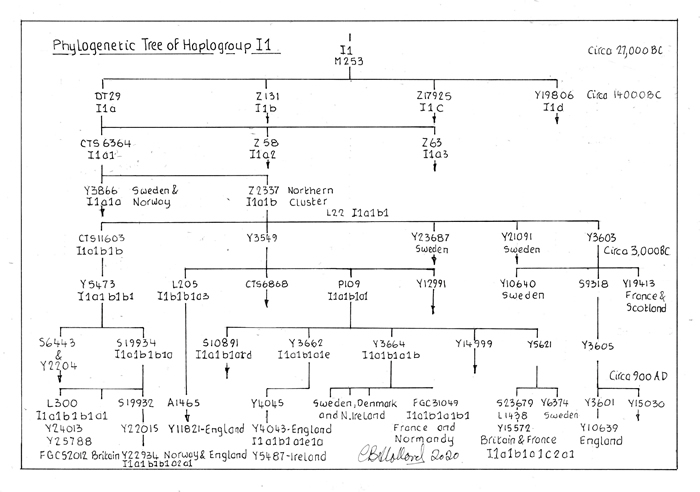 |
| Phylogenetic Tree of Haplogroup I1 |
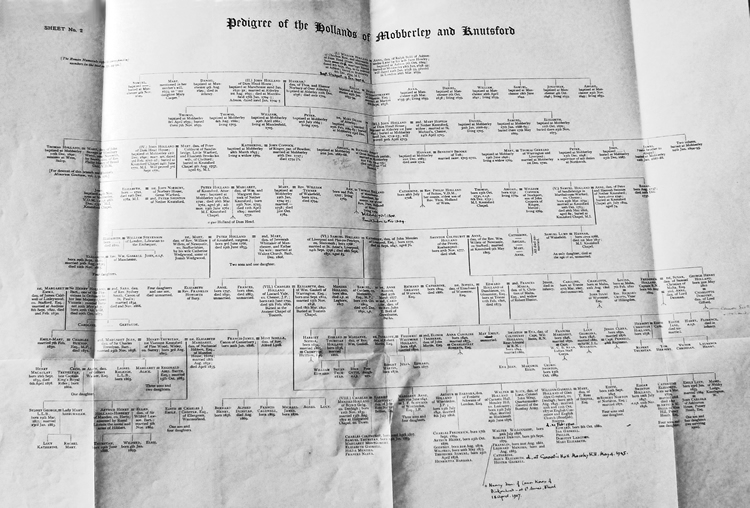 |
| Pedigree - Hollands of Mobberley & Knutsford |
Holland DNA Project
The Holland DNA project was set up early in the 20th century. Participants data was progressively entered onto the website and was readily accessible. By 2013 there were 113 participants whose DNA data appeared on the website. It was therefore possible to compare one’s own data with that existing on the website, the data was grouped by Haplogroup. There were seven different Haplogroups represented including I-M253, of which there were nine participants. This implies that although sharing the name Holland, 80% of their common ancestors were beyond the genealogical timescale.
Of the nine I-M253 participants, none had sufficient common marker points with the same number of model values to have had a common ancestor with ourselves within a 25-generation timescale. This website is no longer actively updated and the DNA data has been removed, possibly another victim of data protection. From this data it would appear that there are many people with the surname Holland in existence that do not descend from either the Hollands of Lancashire or N Wales. Possible alternative origins are: - Lincolnshire; Down-holland, Lancashire; people who changed their name; illegitimate issue; incorrect transcription e.g. Hulland to Holland.
Conclusion
In conclusion, it seems unlikely that these problems will be resolved by DNA methodology any time soon unless someone interested enough, and with very deep pockets and a persuasive personality comes along. Who is to say that sometime in the future someone might decide to catalogue the remains of the identifiable gentry with their DNA as part of some historical project, or tidy up the graveyards to make room for the next generations as happened in the past.
Any Holland researchers interested in using DNA for the purpose of genealogical research, particularly the families referenced here, can get directly in touch with Brian Holland at this email address briaholl2@btinternet.com
Copyright Paul Holland © 2006 - 2022 All rights reserved. Permission is granted for all free personal and non-commercial uses. Sources are available on request. |


